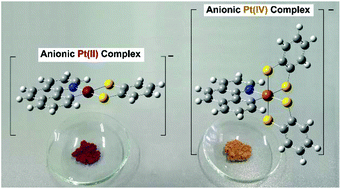Anionic cyclometalated Pt(ii) and Pt(iv) complexes respectively bearing one or two 1,2-benzenedithiolate ligands†
Abstract
Novel anionic cyclometalated Pt(II) square-planar complexes NBu4[(C^N)PtII(S^S)], containing 2-phenylpyridine H(PhPy), 2-(2,4-difluorophenyl)-pyridine H(F2PhPy) and benzo[h]quinoline H(Bzq), respectively, as a cyclometalated ligand and the dianionic 1,2-benzenedithiolate (Thio)2− fragment as an (S^S) ligand, were synthesised. By the simple addition of an equivalent of (Thio)2− to the NBu4[(C^N)PtII(Thio)] complexes, octahedral anionic NBu4[(C^N)PtIV(Thio)2] analogues were obtained, representing, to the best of our knowledge, the first examples of Pt(IV) anionic cyclometalated complexes. The molecular structures of the obtained complexes in the case of the NBu4[(Bzq)PtII(Thio)] and the NBu4[(Bzq)PtIV(Thio)2] complexes were confirmed by single crystal X-ray diffraction analysis. Furthermore, the electrochemical and photophysical properties of the two series of Pt(II) and Pt(IV) newly synthesised complexes were studied and DFT and TD-DFT calculations were performed in order to comprehensively investigate the displayed behaviour. All Pt(II) and Pt(IV) complexes show intense luminescence in the solid state, with remarkable enhancement of the emission quantum yields, proving to be excellent examples of aggregation-induced emission systems.



 Please wait while we load your content...
Please wait while we load your content...